Tx Tees - The Facts
Tx Tees - The Facts
Blog Article
Indicators on Tx Tees You Need To Know
Table of ContentsSee This Report about Tx TeesSome Ideas on Tx Tees You Need To KnowAn Unbiased View of Tx Tees4 Simple Techniques For Tx TeesThe Buzz on Tx Tees4 Easy Facts About Tx Tees ShownTx Tees Fundamentals Explained
That brings your total to approximately $1,900 gross and shipping. Add up various other expenses, like the number of energies it takes to run the store and the expense of ink and emulsion per layout. screen printer. Take the print below for instance. This is a one-color image, so the price of ink per tee shirt is roughly 20 cents.The emulsion ought to only be a few cents because you 'd only need to coat one screen for this task. Typically, printers try to make up to 45% revenue on a print task.

With DTF, you can print a handful of t shirts, or simply one. Utilize the same calculator as the area over to determine how much earnings you 'd make utilizing DTF transfers. Compare the costs and earnings to whichever technique speaks ideal to your configuration and procedure. Both display printing and DTF have their niches in the globe.
Some Known Details About Tx Tees
The most effective way to understand? Ask about and see what print stores like yours are doing. custom monograming. Try both out and see which you like much better
When you're selecting what kind of printing approach to use for printing your artwork styles on your garments, it is necessary that you recognize the differences between these 2 methods so you can maximize results while reducing expenses. Screen printing is the most typically utilized method for printing styles on textiles.
DTG printing is also referred to as spot or direct to garment printing because it prints just what is required instead of making a screen as display printers do. https://businesslistingplus.com/profile/txtees02/. Display printing works by display filler squeegee screen printing ink display mesh screen, after that transferring the picture to garment using warmth and/or pressure
The DTG printer makes use of special dye-sublimation inks that are used into a pre-designed picture by a digital printing system. The inks enter into the material, enabling dynamic colors and remarkable information. It's also recognized as spot or direct to garment printing due to the fact that it prints just what is required as opposed to making a display as display printers do.
Some Of Tx Tees
It's much faster - you can print a fullcolor photo in minutes, as opposed to hours for screen printing. Second, there's no established up time or prices entailed - you can publish any kind of layout you such as, without having to develop a display. Third, there's no waste - due to the fact that display printers display print one style each time, they have to screen each color separately.
The paper is very expensive and can only be made use of as soon as. Once it's published on, it has actually to be thrown out. - The first acquisition cost is lower than the in advance investment of DTG printers- You can print multi-color layouts one display each time rather than needing to publish each shade individually like DTG printing.

How Tx Tees can Save You Time, Stress, and Money.
Rather of using screen mesh as screen printers do, dye sublimation printers make use of laser technology to transfer your pictures onto garments or paper. A warm procedure moves the dye from its solid-state directly into the gas stage which subsequently fuses it onto fabric substrates when they are quickly warmed to high temperature levels under high stress.
Sublimation printing is environmentally friendly. It makes use of much less water than screenprinting, and because it doesn't include making use of unsafe solvents, it's secure for all sorts of garments. The dye sublimation inks are likewise odor discover here free when treated, unlike display printers that make use of harmful chemicals during the screen printing process that leave an undesirable smell.
They also conserve cash on pricey tools like direct exposure devices given that color sublimation printers do not call for a UV direct exposure device or a flash remedy stove that is normally made use of in display printing (custom monograming). What is direct to garment printing (DTG Printing)? DTG printing is an electronic screenprinting procedure that publishes directly onto fabric using specialized inkjet printers
The 6-Second Trick For Tx Tees
DTG printing offers lots of advantages over standard screenprinting, including the capacity to publish photographic top quality pictures, greater shade vibrancy, and the capability to publish styles on darker fabrics. DTG printers function by heating the fabric ink until it develops into a gas. The gas after that permeates the textile, bonding with the fibers to produce an irreversible print.

Screen printers just prepare their screen then begin publishing till they lack product or ink.- There is a variety of knowledgeable display printers throughout the globe, which can be handy for newbies. - It's a slower procedure - screen printers typically have to wait for the ink to completely dry prior to they can print the next color- Display printers need hands-on labor, so there's a higher learning contour and it takes longer to create a top notch style- Screen printing isn't as exact as DTG printing, so you might get some "blood loss" of shades from one component of the picture onto an additional if not done appropriately.
The Ultimate Guide To Tx Tees
Nonetheless, rather than using screen mesh as display printers do, dye sublimation printers make use of laser innovation to move your pictures onto garments or paper. A warm process transfers the color from its solid-state directly right into the gas stage which consequently fuses it onto fabric substratums when they are swiftly heated up to heats under high pressure.
Sublimation printing is eco-friendly. It utilizes much less water than screenprinting, and because it doesn't entail using dangerous solvents, it's safe for all sorts of clothing. The color sublimation inks are also odor-free when healed, unlike screen printers that utilize dangerous chemicals during the screen printing process that leave behind an unpleasant odor.
They additionally conserve money on expensive tools like direct exposure devices since dye sublimation printers don't need a UV direct exposure unit or a flash remedy oven that is usually made use of in screen printing. What is direct to garment printing (DTG Printing)? DTG printing is an electronic screenprinting process that publishes straight onto textile making use of specialized inkjet printers.
The Basic Principles Of Tx Tees
DTG printing provides many advantages over typical screenprinting, including the capability to print photo quality pictures, higher color vibrancy, and the capability to print layouts on darker textiles. DTG printers function by heating up the textile ink till it transforms right into a gas. The gas then permeates the textile, bonding with the fibers to develop a long-term print.
Report this page